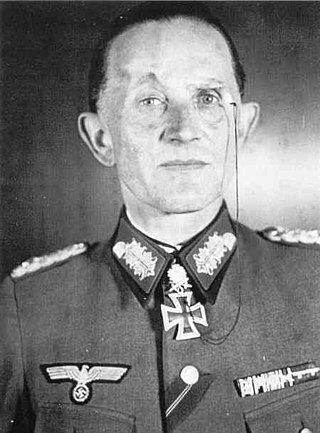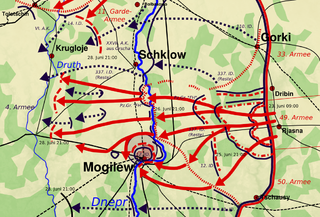
The Panzergrenadier Division "Großdeutschland", also commonly referred to simply as Großdeutschland or Großdeutschland Division, was an elite combat unit of the German Army that fought on the Eastern Front in World War II.

The 10th Panzer Division was an armoured division in the German Army, the Heer, during World War II, established in March 1939.

Dietrich Friedrich Eduard Kasimir von Saucken was a German general during World War II who commanded the 2nd Army and the Army East Prussia. Turning down an offer to escape by air, he surrendered to the Red Army in May 1945. Saucken was the last officer to be awarded the Knight's Cross of the Iron Cross with Oak Leaves, Swords and Diamonds of Nazi Germany.

The 9th Panzer Division was a panzer division of the German Army during World War II. It came into existence after 4th Light Division was reorganized in January 1940. The division was headquartered in Vienna, in the German military district Wehrkreis XVII.

III Army Corps was a corps level formation of the German Army during World War II.

The 12th Infantry Division – later known as the 12th Volksgrenadier Division – was a Wehrmacht military unit of Nazi Germany that fought during World War II. The division was formed in 1934. It participated in the invasion of Poland in 1939 and the 1940 campaign in France and the Low Countries. In the Soviet Union, the division joined Operation Barbarossa. The division was destroyed in the Soviet Operation Bagration in the summer of 1944. The division was re-activated in September 1944 and posted to the newly created Western Front.

The 4th Panzer Division was an armored division in the Army of Nazi Germany.
The II SS Panzer Corps was a German Waffen-SS armoured corps which saw action on both the Eastern and Western Fronts during World War II. It was commanded by Paul Hausser during the Third Battle of Kharkov and the Battle of Kursk in 1943 and by Wilhelm Bittrich on the Western Front in 1944.
The Panzerkorps Feldherrnhalle was a German army corps that fought on the Eastern Front during the Second World War. It was formed of Sturmabteilung (SA) members. Unlike the Waffen-SS, Feldherrenhalle operated under the Wehrmacht Heer.

The 56th Infantry Division was a German infantry division which fought during World War II.

Otto von Knobelsdorff was a German general during World War II who led the 19th Panzer Division and then held a series of higher commands. He was a recipient of the Knight's Cross of the Iron Cross with Oak Leaves and Swords.
The XXVII Corps was an infantry corps in the German army. It fought in several notable actions during World War II.

The Mogilev offensive was part of the Belorussian strategic offensive – commonly known as Operation Bagration – of the Red Army on the Eastern Front of World War II in the summer of 1944. Its goals were to capture the city of Mogilev and to pin down and trap the bulk of the German Fourth Army. The offensive fulfilled both objectives.

The Minsk offensive was part of the second phase of the Belorussian strategic offensive of the Red Army in summer 1944, commonly known as Operation Bagration.

Operation Doppelkopf and the following Operation Cäsar were German counter-offensives on the Eastern Front in the late summer of 1944 in the aftermath of the major Soviet advance in Operation Bagration with the aim of restoring a coherent front between Army Group North and Army Group Centre. The operation's codename was a reference to the German card game Doppelkopf.
Panzer-Division Clausewitz was a German panzer division during World War II, named for Carl von Clausewitz.
XLVII Panzer Corps was a panzer corps of the German Army in World War II that was formerly designated as XLVII Corps. Various formations of the corps fought in the French campaign of 1940, in the invasion of Soviet Union from 1941 to 1944, and on the Western Front from June 1944 until April 1945.

The 25th Infantry Division was a military unit of the German Wehrmacht. It was later reclassified to 25th Motorized Infantry Division, and in June 1943 to the 25th Panzergrenadier Division.

The 36th Infantry Division was a German infantry formation of World War II. It was formed in Kaiserslautern on 1 October 1936. During World War II it was mobilized in August 1939, as part of the first wave. It was later reorganized and re-designated the 36th Infantry Division (mot) in November 1940. It was then de-motorized, reorganized and re-designated the 36th Infantry Division on 1 May 1943. The division was destroyed at Bobruysk in June 1944 during the Soviet Operation Bagration. It was reformed on 3 August 1944 as the 36th Grenadier Division and renamed the 36th Volksgrenadier Division in October 1944.

The Panzergrenadier Division Feldherrnhalle, was a semi-armoured formation of the German Army during World War II.














